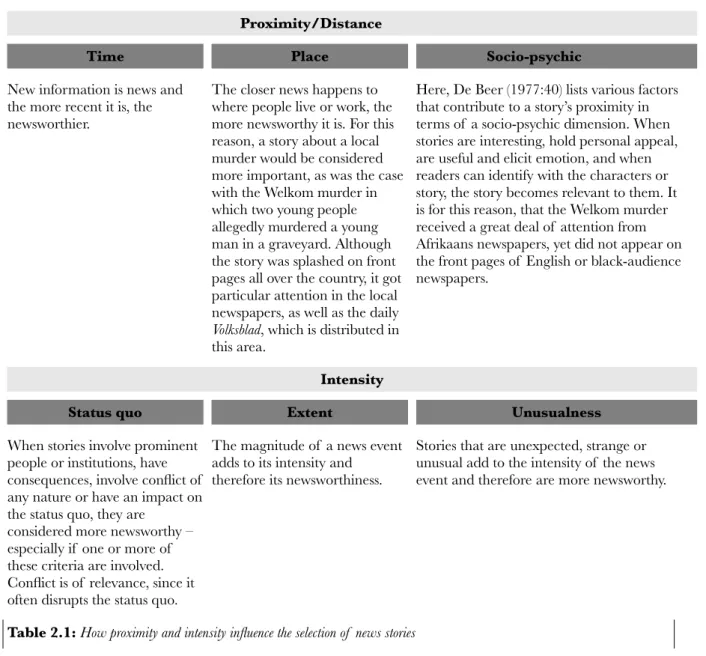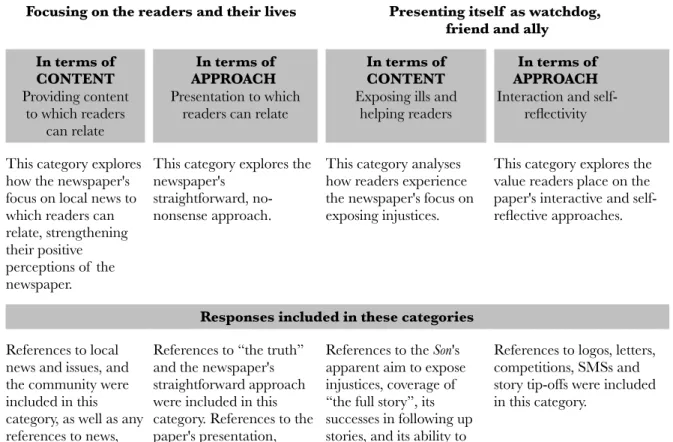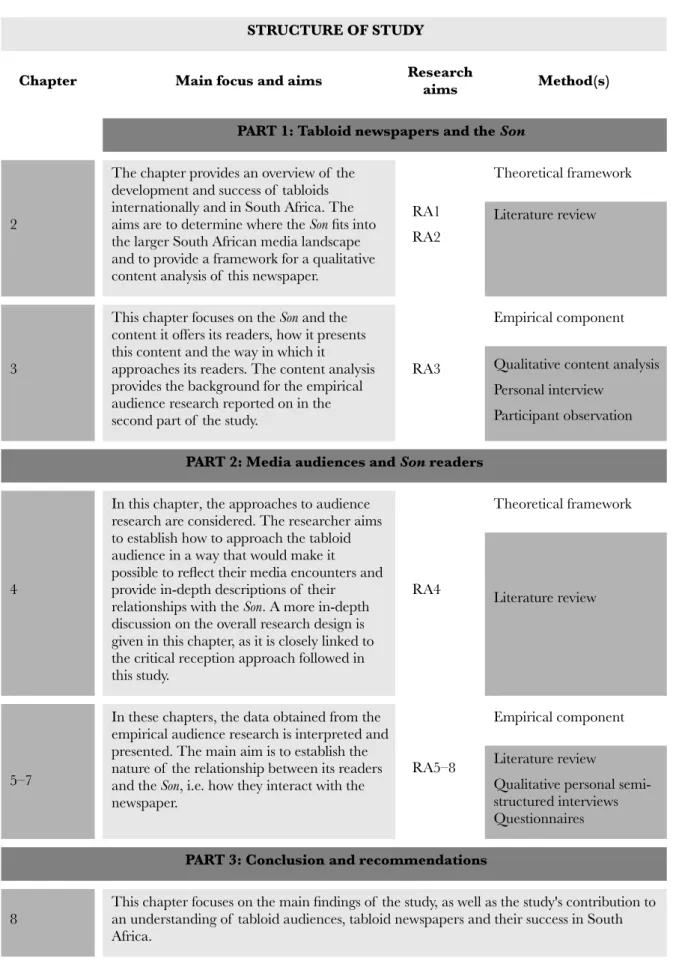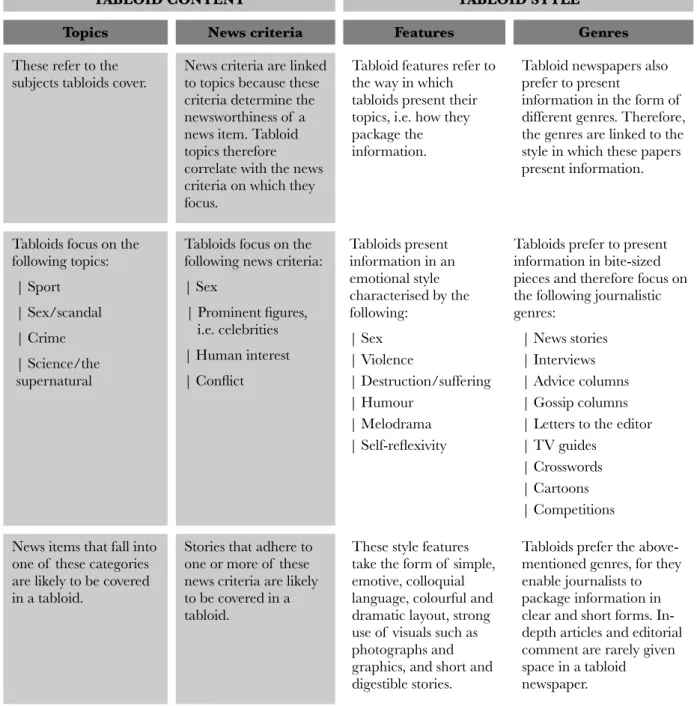This study argues that if researchers and practitioners are to understand the extent of the impact of tabloids on the media landscape and society, we must consider the reader as a significant factor in these newspapers' success. How do the readers of the Afrikaans tabloid Son use and make this newspaper.
RESEARCH QUESTIONS AND AIMS .1 Specifc research questions
Specifc research aims
RA7: determine how the S o n fits into the daily lives of its readers through open-ended questionnaires and personal semi-structured interviews; RA8: determining the media context in which readers of de Son use this tabloid through open questionnaires and personal semi-structured interviews.
MAIN THEORETICAL STATEMENTS
In this connection, reception researchers believe that if we are to understand the relationship between the audience and texts, it is crucial that we pay attention to the audience's perceptions and interpretations as well as to the media texts themselves. Reception scholars therefore recognize that the encoder and decoder of the message play a crucial role in the meaning-making process, and for this reason, they argue, there should be a balance in terms of attention to the text and to the readers.
RESEARCH DESIGN
Within this framework, the study follows a critical reception approach to examine the Son's role in the lives of its readers (see section and 3.4.4). The purpose of the study is not to generalize results or to profile the reader of the Son.
Tabloid newspapers and the Son
CHAPTER OUTLINE
Chapter 2: A social phenomenon
The reader, the king A focus on the Son's main features
Chapter 4: In search of the audience
Negotiating meaning
The community's champion Reader perceptions of quality journalism
The Son as a companion
Chapter 8: Sonland: Where readers have a voice
Chapter 2 A SOCIAL PHENOMENON
INTRODUCTION
LO1: determine the history and development of tabloid newspapers through a literature review; and RA2: to determine the main features of tabloid newspapers by means of a literature review.
RESEARCH METHOD 4
HISTORY AND DEVELOPMENT OF TABLOID NEWSPAPERS
- News and sensation in the sixteenth century
- The Penny Press
- The Yellow Press
Instead of calling the woman a "prostitute", the newspaper chooses to use the more sensational and dramatic term "prostitute" (Stephens, 1997:104). He believed that "merely important" news was "addressed only to a small audience" (MacGill Hughes, 1942:12).
THE MAIN FEATURES OF TABLOID NEWSPAPERS
- Tabloid content
- Tabloid style
- Tabloid genres
- What is news?
- The tabloid approach
- What do readers want?
- Criticism of tabloids
- Tabloids and quality journalism
Thus, the focus shifts from academic opinions to reader opinions (see section 1.1). Wasserman (2010:67) states: "Criticism of tabloids eventually dragged into the question of whether they could even adhere to the definition of journalism." He implies that it is futile to discuss quality tabloid journalism if members of the profession cannot agree on the recognition of tabloid media as journalism.

CONCLUSION
This means that a quality tabloid newspaper must report on issues that are important and relevant to its readers and their lives. It should also not be afraid to do so by following a different approach or style, because a quality tabloid has a responsibility to communicate to its audience in an understandable, clear and attractive way.
Chapter 3 THE READER, THE KING
INTRODUCTION
RESEARCH METHOD AND SAMPLING
It was therefore essential to determine the manner in which Sin approaches its readers before exploring audience interpretations of the newspaper (see Sections 4.3.2.3 and 4.3.3.1). It provided the researcher with valuable documents on tabloid politics, as well as the research design and initial results of the newspaper's own study (see Sections 4.2 and 4.4).
FINDINGS
- The content and style of the Son
- The communication approaches of the Son
Posing suggestively in tiny bikinis and sometimes in underwear, these girls were generally scattered to the side, as shown in Illustrations 3.3 and 3.4 (see Appendix B, Illustration 3.3: . Son's ex-girlfriend on the third page, as appeared during the week [Monday 16 August 2010] and Illustration 3.4: Son's ex-girlfriend on page three when it appeared on Fridays [Friday 18 September 2009]). One cartoon showed two people removing their aerial to fool "the TV licences". Community initiatives are particularly highlighted, as illustrated by this front-page story in Illustration 3.6 (see Appendix B) (Illustration 3.6: Son supports community upliftment and crime-free initiatives [Wednesday 14 October 2009]).
His behavior towards women is appalling.] [ACDP is the solution to voters' problems] [ANC is making fools.
CONCLUSION
The content of the tabloid resembles the world in which the audience lives. A content analysis of the Sun indicates that this tabloid focuses on crime, local news and positive stories. The impression is created that especially the new version of the Son considers positive news, the reader and his/her participation, and community news as the main focal points.
Content analysis therefore suggests that Sin functions as both a tabloid newspaper and a community newspaper.
Chapter 4 IN SEARCH OF THE AUDIENCE
INTRODUCTION
RESEARCH METHOD
Therefore, other relevant media audience studies, such as the reception of soap operas and reality television programs, will also be discussed in this chapter (see section 4.4.3 for a detailed discussion of the research methods used in this study).
THE TRADITION OF AUDIENCE RESEARCH
- The functionalist approach to the media audience: Uses and gratifcations .1 Audiences and their needs
- Contemporary approaches to the media audience: Media ethnography .1 The nature of the audience
- Contemporary approaches to the media audience: Reception .1 Text and reader: Two sides, one coin
The receiver of the message therefore plays a critical role in the meaning-making process (see Jensen & Rosengren Morley, 1980:7). Reception research is concerned with media consumption in the context of the audience's everyday lives (Johansson, 2007:54; Schrøder et al. Which approach will enable the researcher to investigate media audiences who are on the side of the audience.
The researcher should also be aware of the nature of audience research and have a more modest goal.
RESEARCH DESIGN
- Approaching audiences qualitatively
- Literature study
- Empirical study
In this case, literature research, qualitative content analysis, qualitative interviews and observations were used to obtain information (see Schrøder et al., see section 3.4.4). ii) The researcher can develop themes and categories to describe and interpret experiences. The purpose of this research is similar to that of Johansson's thesis on British tabloid readers: the researcher's aim is not to generalize findings, in other words to provide a profile of the Son's readership, but rather to gain insight into and understand who the readers are. ' relations with the newspaper (see Johansson. The literature review, supplemented with a qualitative content analysis and interviews (see section 1.5.3), also provided the background against which the researcher conducted the audience survey (see section 2.2 for an extensive discussion of the literature review) .
The chapter will also include a discussion about the obstacles that the researcher had to overcome, as well as a reflection on her role during this process (see section 4.2).
CONCLUSION
Media effects research focuses on textual analysis and does not place a value on the experiences or interpretations of the audience. The nature of public research and the role of the researcher in this process were also briefly mentioned. These include: (i) a literature review to put South African tabloids in context; (ii) a content analysis of the Son and interviews with the assistant editor to determine how this paper builds a relationship with its readers; and (iii) questionnaires and semi-structured interviews with readers to gain insight into their media experience and interpretations of the Son.
Moreover, it is essential that the readers of the tabloid, as well as their interpretations and interactions with the newspaper, be taken seriously.
Chapter 5 NEGOTIATING MEANING
INTRODUCTION
RESEARCH METHOD
- Questionnaires and personal interviews
- Recruitment of participants
- Obstacles in the recruitment and data collection processes
A total of 74 readers of the Son participated in the study, of whom 59 completed questionnaires, and 17 participated in face-to-face interviews (note that two interviewed respondents also completed questionnaires). Most of the respondents were willing to be interviewed and some, who were more in a hurry, filled in the questionnaire. Although most of them agreed to participate, this still meant that the researcher had to spend time talking to people who were not readers of the Son.
All these documents are in the possession of the researcher and some have been included in this study.

THE READERS: A BACKGROUND
- A community displaced
- Life in the new South Africa
- Who reads the Son?
While people of color were once not white enough to share the privileges of the white community, now they are not black enough to win under the new regime (see Adhikari, 2006:480). The age group of participants shows that people of all ages read the newspaper. As can be clearly seen from the table, most of the respondents had some form of education.
The nature and size of these families was therefore kept in mind in the examination of readers' experiences and interpretations of the Son.

NEGOTIATING MEANING
- Reader experiences and interpretations regarding content .1 Crime news is prime news
- Reader interpretations of style and presentation
A retired 63-year-old male respondent said that the Son provides him with the "news of the day". The majority of respondents said that the newspaper creates awareness of especially criminal activities in their community and in the Western Cape. One reader indicated that the mainstream Die Burger and Die Seun sometimes cover the same story.
Two men (aged 25 and 45, respectively) indicated that this content attracts them to the newspaper, but that the newspaper's sports coverage did not impress them. The mother-of-two revealed that the page-three girls didn't bother her at all. The above answers also indicate that readers are aware of the newspaper's visual signage system, i.e.
CONCLUSION
Readers seem to appreciate the effort the newspaper goes to to provide them with all the details of the story. Respondents indicated that the newspaper provides them with information that they can use in their lives. In addition, the use of language is also to the readers' taste and many of them indicated that they buy the newspaper for this very reason.
Overall, the responses indicate that readers find the content in the newspaper relevant and useful to their lives, and that they appreciate the way the newspaper presents this information to them.
Chapter 6 THE COMMUNITY'S CHAMPION
INTRODUCTION
RESEARCH METHOD
THE SON'S APPROACH TO ITS AUDIENCE
- Focusing on readers and their lives
Twenty-nine of the 71 respondents who had positive comments about newspaper quality stated that "good" newspapers highlight news about the reading community. This conversation is important because it reiterates the idea that readers find meaningful and applicable information in the newspaper (see Kovach. & Rosenstiel Motloung, 2007; Joseph, 2005a:31; section 2.4.8.1). Readers therefore seem to believe that the paper reflects common issues, interests and aspirations.
This woman believes that the newspaper provides her with the information she needs to organize her daily life, even though she lives in a rural area.



